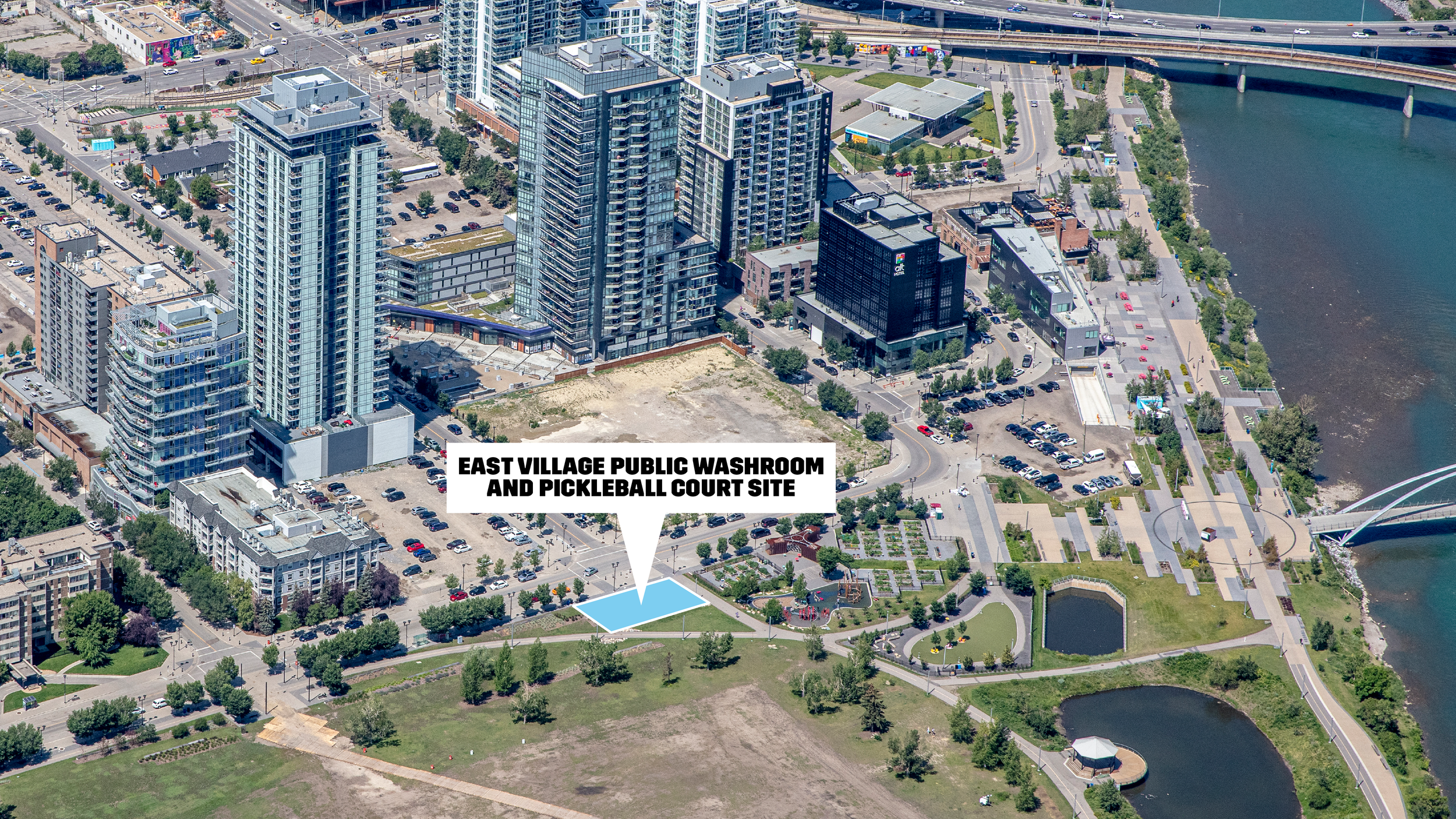Innovation in Design: Public Washroom + Pickleball Court
It all started with a little competition! In late 2022, Calgary Municipal Land Corporation (CMLC), the master developer of East Village, launched a design competition for public washrooms in East Village with a call out challenging designers to “push the boundaries on the form and function of a conventional public washroom facility”.
Today, the winning design was revealed, and the result is an innovative design that redefines what people can expect from traditional public spaces. We caught up with Liz Wreford and Peter Sampson, Founding Directors and Principals of Public City Architecture, winners of the design competition, to learn more about the inspiration behind their unique take on the modern public washroom.
Conceptual rendering of the new East Village washroom which features four universally accessible bathroom stalls, a shared handwashing space and hand drying station.
EV: You submitted a Request For Proposal (RFP) for a design competition for public washrooms in East Village – what was it that interested you about the project?
Public City: We saw an opportunity to transform a functional amenity into an active place for people as well as a chance to challenge the narrative, and the general perception of public washrooms. Public washrooms can feel unsafe. We’ve all experienced it - they’re isolated, small, tend to be overlooked and are often avoided.
Through the design of the building, we are addressing these concerns by making the washrooms more open and visible from the outside looking in. The addition of a pickleball court creates a more public, active space which encourages an eyes-on-the-street approach to safety. More people using the space for multiple purposes provides a greater sense of safety.
EV: Tell us about what you designed?
Public City: The building is a vibrant, busy, and play-filled addition to East Village that is accessible at street level. It compliments the adjacent community garden, playground and dog park and provides an important amenity to users of those existing spaces and visitors to the community. It also is a great recreational space steps away from existing and future residential buildings.
Conceptual rendering of the new 3,000-square-foot East Village washroom from 6th Street SE.
EV: This isn’t your typical public washroom! Can you share some insight into how you came up with your innovative design?
Public City: We wanted this to be something more than just a washroom and approached the project with the goal of creating a place that is active and engaging, rather than a pit stop. A bit of a “more is more, less is boring” attitude. By pairing the site with the fastest-growing sport in North America – pickleball – the building attracts a broader range of users to the space and contributes to the overall liveliness of East Village.
The growth of pickleball has been so explosive over the past few years, we saw an opportunity to not only help amplify the playfulness of the game, in a bright, new, inviting court but to also add a sense of wonder into the park space. For us, it was always pickleball!
The colours we chose for the building – bright yellow and green – invite curiosity and create a moment of intrigue for people passing by. We want people to pause and want to learn more about the space. East Village is a vibrant, lively, desirable urban neighbourhood – we wanted to design something that added to that.
Conceptual rendering of the fenced-in outdoor pickleball court at the East Village Washroom.
EV: Have you ever designed public washrooms before? If so, what were some of your key learnings from that experience and how did they impact your design for these ones?
Public City: We’ve been designing award winning public washrooms for the past 15 years and we’ve learned that location and placement play an important role in their success. Isolating these facilities can turn them into bunkers. We’ve made it our mission to make these public spaces inviting places, that are seamlessly integrated into their surroundings.
EV: Can you tell us more about some of your past projects?
Public City: We do urban activation projects and incorporated learnings and inspiration from some of our past projects into the design of this one.
Manitoboggan
The inspiration here is Accessibility + Form + Play. This project is composed of a barrier-free and universally accessible toboggan slide with two toboggan chutes, a four-season warming shelter, a treetop ramp walkway through the forest, and a viewing deck facing the slides. This is the world’s first universally accessible toboggan slide and was inaugurated by Winnipeg’s very own Paralympian and 5-time medalist Billy Bridges. Activating the public realm through sport and activity is important to our work.
Forest Pavilion
The inspiration here is Multifunction + Seasonal Flexibility. Similar in function, here’s a public washroom that also serves as a warming shelter and gathering area. This is a floodable structure that has three different types of community gathering spaces to accommodate multi-aged demographics and multi- seasonal uses. Designing to accommodate for diversity in demographics is a consistent theme in our work.
Assiniboine Park Washrooms
The inspiration here is Sustainability + Colour. Three decommissioned shipping containers were reconfigured into public washrooms. The use of intense and vibrant colours has created a beacon in this otherwise dark corner of a civic park. The mirrored glass that reflects the surroundings during the day becomes something other at night when the vibrant colours bleed through. Colour is a very important material in the public realm.
EV: What factors were considered when determining the location for the washrooms?
Public City: We wanted to make use of existing infrastructure while developing a street edge and place the washroom at a crossroad. The selected location puts the washroom close enough to the street, where there is good lighting, and is close to the community gardens and playground where there is existing traffic and activity.
EV: What are some of the safety and accessibility considerations/features that were incorporated into the design? Why were these important?
Public City: It would be a disservice to the community if safety wasn’t the number one concern. The transparency of the windows and fencing provide strong sightlines, and fluid circulation pathways around the facility provide a sense of security while games of pickleball provide a steady flow of activity around the public washroom.
EV: What was the most challenging part of the design for you?
Public City: Designing a place that is public and feels open while making it safe, maintainable, durable and affordable is a challenge for all public architecture. There’s a character of openness to the project that intends to convey a feeling of lightness and whimsy; an invitation to passers-by.
EV: When the public washrooms open later this year, how do you hope to see people interacting with the space?
Public City: Flushing toilets, washing hands, and playing pickleball! Design excellence is not achieved by satisfying metrics and basic program needs.
“Excellence is achieved by doing more than you are asked to do. Designing better, designing for people before function - these are all critical to every good project. What makes a project excellent to us is being able to invest in a sense of delight and joy that, we hope in the end, fosters a sense of stewardship of place.”
Project timeline
Construction on the East Village washrooms and pickleball court is set to began in April 2024 and the doors officially opened in January 2025. Learn more about the operational model of the space here.
About Public City Architecture
Public City Architecture is an award-winning, multidisciplinary architecture and landscape architecture studio based in Winnipeg and practicing across Canada. You can find some of their work right here in Calgary including the beloved High Park in the Beltline and the award-winning PARK PARK in Inglewood.
Liz Wreford is a landscape architect whose work contributes to public spaces that are joyful, celebratory, and designed to shape identity. As the co-founder and principal landscape architect of Public City, Liz has over twenty years of experience as a landscape architect, business owner, teacher, mentor, and public artist.
Peter Sampson is the Principal Architect of Public City based in Winnipeg. Peter is interested in the pleasure of making and inhabiting an architecture that is striking, joyful, healthy, and balances itself within its natural, human, and economic contexts.







